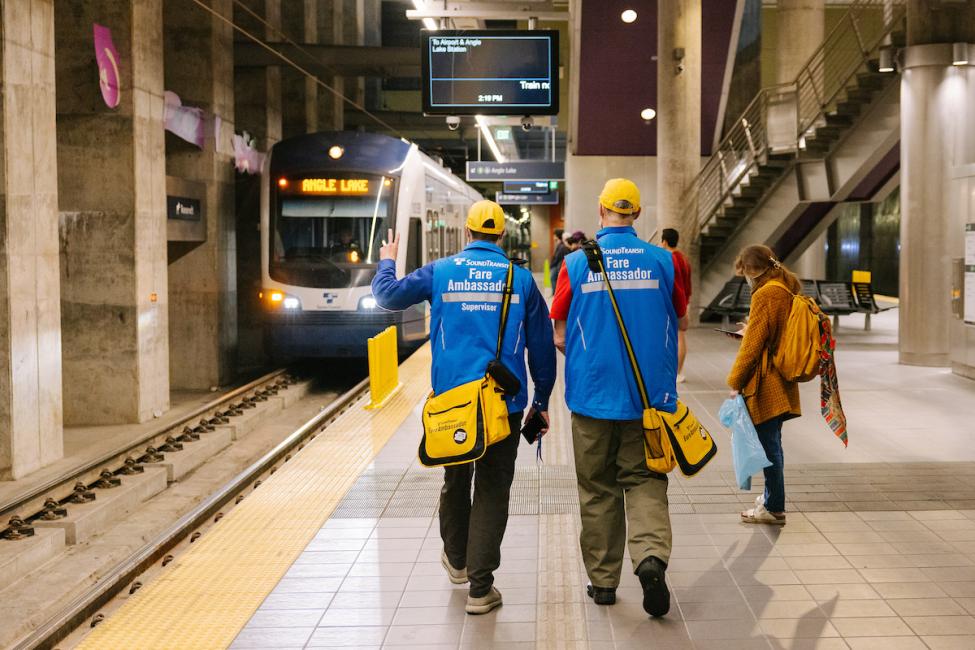If you’ve ridden Link light rail, you’ve probably met our yellow-capped Fare Ambassadors as they methodically move through trains, checking ORCA cards and tickets and helping passengers.
Starting June 3, you can also expect to see them checking fares on some 1 Line station platforms in downtown Seattle, and at more stations in the months ahead.
We’ll be trying a few different methods for off-board fare checks within “fare-paid zones” this summer and fall, and passenger feedback will help us define a new standard procedure for next year and beyond.
Why the change? Fare revenues are a crucial component of Sound Transit’s funding for operating the regional transit system. In fact, they’re a key part of the transit plans voters approved in 1996, 2008, and 2016. Without fare revenue, we would need more revenue from other sources, such as taxes.
So making sure every ride is paid for (including through subsidized passes like ORCA Lift for low-income passengers or the Free Youth Transit Pass for riders 18 and under) is an important priority for us.
Going forward, this new procedure will allow our Fare Ambassadors to reach more passengers and check more fares every hour. It will especially improve efficiency during peak periods when trains are most crowded (and as we shared earlier this spring, we’ll need to work even harder to reduce crowding once thousands of new riders join the system after the 1 Line extension opens to Lynnwood on Aug. 30).
More fares checked will also mean more fares paid, since Fare Ambassadors will be able to offer more options beyond just a warning or citation if they encounter someone without a valid tap or ticket on the platform. Forgot to tap? Need help buying a ticket? Wondering how to get a free youth transit pass? No problem, now that Fare Ambassadors will be on the platform to help.
This new approach will help Fare Ambassadors better provide all the customer service resources they currently offer on trains – from information on reduced fares for seniors and passengers with disabilities, to connecting with security staff on safety issues, to navigation and wayfinding for first-time visitors to the region.
As our system keeps growing, we’re working to make it more convenient and more accessible for thousands more riders every day. That means making our staff more accessible throughout that system, ensuring every passenger has a great ride.
How we re-envisioned fare enforcement
In late 2018, Sound Transit kicked off a nearly three-year process to rethink how we managed fare compliance on our system. It included researching what our peer agencies were doing across the country, and conversations with local stakeholders and community members – particularly those disproportionately affected by previous enforcement policies and procedures.
These findings helped us craft a new fare engagement approach, which the Board approved in 2022. It included creating the Fare Ambassador program you know today, overhauling our process for warnings and fines, and a low-income fares pilot program.
It also included adding platform fare checks in the future.
But first, we invested in lots of high-visibility yellow station signage to help signal more clearly to passengers when they’ve entered the “Fare-Paid Zone” and should be ready to show their proof of payment.
What to expect when you ride
You can think of this summer as a testing phase for new platform fare checking procedures. For now, they’ll only be happening on the Link 1 Line (not on the 2 Line, T Line, or Sounder), and only at downtown Seattle stations, especially during peak periods. And you can still expect to see Fare Ambassadors onboard trains as usual.
Fare Ambassadors will be testing out different methods of moving through the platforms, with a goal of providing you with an easy, predictable, and fair experience similar to onboard fare checks – where teams start at opposite ends of the car check every passenger.
With a little extra time and a lot more elbow room on platforms, Fare Ambassadors will be able to provide better customer service.
In addition to checking fares, documenting interactions, and issuing violations when needed, teams also teach passengers how to use the system and navigate the region, help with ticket machines, and provide guidance on how to choose and get the ORCA card that’s right for them. They can also help passengers through service disruptions, report a problem with an elevator or escalator, connect with security or station agents, and help riders connect with social or emergency services if needed.
If you have your fare checked on platform during our summer testing phase, we want to hear how it went. You’ll be invited to share your experience through a survey, and your feedback will help us refine our process going forward.
We plan to expand platform checks to other stations later this fall and into 2025, then finalize our new procedures by 2026, when our region welcomes FIFA World Cup spectators from around the globe.
Stay tuned to The Platform blog for more updates and be sure to sign up for email or text alerts so you’re always ready to ride.

